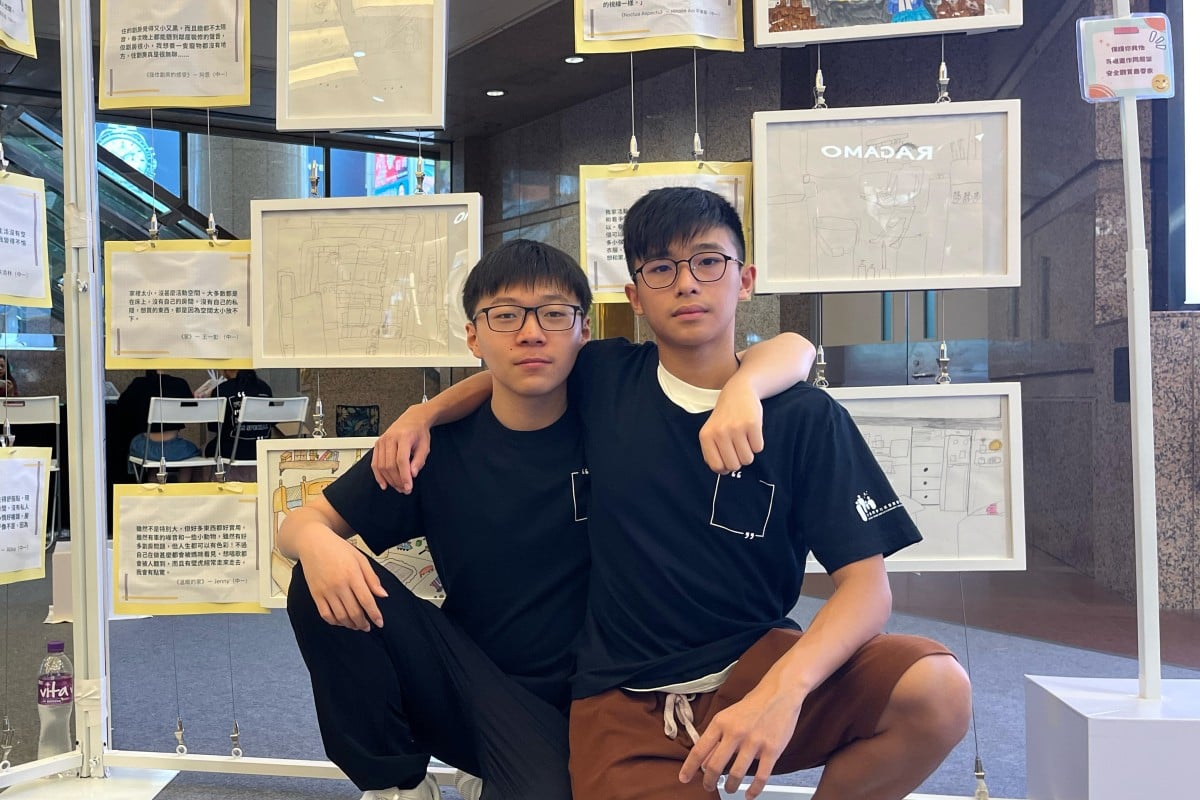
Children’s drawings show life in Hong Kong subdivided flats: homework, meals on the toilet
- A teen from the exhibition by NGO Social Work Dream says he studies and eats on the toilet in the 120 sq ft flat he shares with his family
 Secondary school students Matthew Wang (left) and Gordan Jian have written stories and created drawings to reflect their experiences living in subdivided flats. Photo: Kelly Fung
Secondary school students Matthew Wang (left) and Gordan Jian have written stories and created drawings to reflect their experiences living in subdivided flats. Photo: Kelly FungThe bathroom is where Form One student Gordon Jian usually spends time in his cramped home in Sham Shui Po. With the family’s only desk given to his younger sister, the 14-year-old has no choice but to do his homework and sometimes even eat on the toilet seat.
Still, this tiny, damp space has become his sanctuary.
“When you’re feeling down and want some time alone, it’s impossible. The bathroom is where I go,” he shared, noting that he has lived here with his family for eight years.
Home to a household of four, the 120 sq ft unit is smaller than a typical parking space, which is about 160 sq ft.
“Every day, we live on edge because these places are infested with cockroaches and rats,” he said.
Gordon said his ideal home would have three rooms and a living room.
Hong Kong scheme to mentor pupils living in subdivided flats
Hong Kong is notorious for its subdivided flats. According to a 2021 study by the Hong Kong Council of Social Service, people in these units have an average living space of only about 30 sq ft per person.
As of 2021, 34,000 children under 15 were living in small, cramped flats in Hong Kong. However, most initiatives approach this issue from adults’ perspectives, rarely giving a platform for youth to voice their needs and feelings.
To fill this gap, NGO Social Work Dream invited 50 children residing in Sham Shui Po’s subdivided housing to share their feelings about their homes through drawings. Earlier this month, these poignant illustrations were showcased in Causeway Bay for a three-day exhibition.
Feeling suffocated
More than 215,700 people live in subdivided units in Hong Kong. About 132,000 households are waiting for public housing flats with an average waiting time of 5.6 years.
In last October’s policy address, Chief Executive John Lee Ka-chiu said that his administration would work to put an end to low-quality subdivided housing.
Abby Tang, 26, Social Work Dream’s children and youth project leader, explained that the goal was to provide youth with a space to discuss their experiences.
“They all crave personal space, but many still share rooms with family members. So everything they do is actually fully exposed, with everyone around ... [Imagine] wanting to cry but having nowhere to hide,” she said.
“Living in such a small place where even walking a few steps might disturb others, it actually affects their emotions a lot.”
She noted that on average, the NGO’s beneficiaries had been waiting for public rental housing for eight years.
Hong Kong set to open ‘community living room’ for residents of subdivided flats
Having collected drawings for the exhibition since January, Tang recalled how one of the participants depicted her home using only black and white colours to convey her unhappiness. Another student drew a sofa because her father could only sleep on the floor.
“What she really wants is just for her father to have a more comfortable place to sleep, but this seems like a luxury,” Tang said.
To foster empathy towards children living in these challenging conditions, the exhibition set up a board for visitors to leave supportive messages. Tang shared that one visitor even gifted an eye mask after a student’s drawing depicted how a street lamp affected her sleep.
Adrian Low, president of the Hong Kong Association of Psychology and a chartered psychologist, described some impacts of growing up in cramped spaces: “Children may struggle to establish a healthy sense of personal boundaries, which can impact their ability to regulate emotions and interact with others.”
He noted that they might also develop anxiety from the constant exposure to noise and limited opportunities for play and relaxation. This may make it challenging for children to manage their feelings, leading to strained family relationships.
“The close proximity and limited privacy in subdivided flats can increase the potential for conflict and tension within the family,” Low said.
Small homes, high hopes
Another Form One student who took part in the initiative is Matthew Wang Yipeng, who sketched a layout of his cramped home emphasising the merged kitchen and toilet, with his bed right next to them.
“Whenever I take a shower or use the bathroom while my mother is cooking, the fumes make my nose uncomfortable,” said the 14-year-old, whose family is currently waiting for public rental housing.
Having lived for three years in a unit that is around 100 sq ft, Matthew’s biggest wish is to get a job one day that allows him and his mother to live comfortably: “I want to buy a flat for my mum.”
He added: “My mum is afraid that I might have emotional issues if I live here, so she always encourages me to study hard ... She also told me that she would work hard to earn money so that I can live in a big flat.”
In January, the Concerning Subdivided Units Alliance published a survey on the rental conditions of Hong Kong’s subdivided flats. It found that more than 70 per cent of respondents risked being overcharged for utilities as they had not seen the official electricity or water statements. However, many do not report their landlords as they fear retaliation.
The Jian family is among the tenants struggling under these exploitative practices. Gordon’s mother, Jian, who preferred to only give her surname, said her primary issue was with water and electricity costs.
For example, while the first 12 cubic metres of water are free under the Water Supplies Department guidelines, Jian explained that their landlord would charge them about HK$10 per cubic metre. But she has not been shown the official water statements.
She lamented how her unit’s monthly water bill was almost equivalent to the annual amount paid by public housing residents she knows.
For now, Jian can only wait for her family’s chance to move into public housing: “So my kids would have their own bed, and there would be a bookshelf and a desk for them to do homework ... [and] space to hang their clothes.”
Sanctuary 避難所
A place of refuge or safety.
Exposed 無遮蔽的
Not protected or covered; revealed or made visible.
Beneficiaries 受助人
People who receive advantages, profits, or benefits from something.
Boundaries 界線
Limits or borders that define the extent of something.
Strained 繃緊的
Stressed, tense, or characterized by difficulty or discomfort.
Retaliation 報復
An act of revenge or punishment in response to a perceived wrong.
Exploitative 剝削的
Taking advantage of someone or something for personal gain, often in an unfair or unethical manner.
